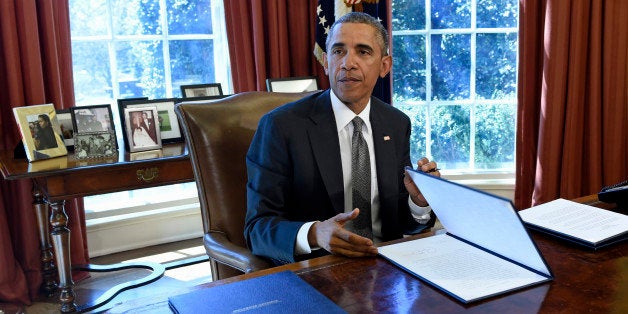
Buried beneath the Holy Week headlines about a religious freedom law in Indiana was a remarkable event: President Obama shortened the sentences of 22 federal prisoners under the pardon power, and wrote them a letter. It was a fitting gesture for a season of hope and renewal.
In themselves, the clemency grants were striking. The total for that one day, March 31, 2015, was only two short of the 24 total prisoners granted commutations by presidents Ronald Reagan and George W. Bush over a combined 16 years. All of them were non-violent narcotics offenders, some of whom were serving life terms under laws and guidelines that have since been reformed. Almost all of them will be released on July 28 of this year.
Perhaps the deeper story, though, was the letter that the president sent to the recipients, which was a message from the most powerful person on earth to the least powerful -- a message of great hope. In that letter, President Obama told the joy-filled recipients that "The power to grant commutations is one of the most profound authorities granted to the President of the United States. It embodies the basic belief in our democracy that people deserve a second chance... "
In closing, the president said something telling: "I believe in your ability to prove the doubters wrong." President Obama knows that his own credibility rests on that very thing; if the doubters are proved right because a clemency recipient commits a violent crime, it will undermine his ability to exercise the pardon power in the future. In an odd and beautiful way, there was a social compact forged through clemency between the President and the prisoner. It is a Shakespearian story arc, a wormhole of mercy between the very top and the very bottom of society.
It befits the morality of our nation that the pardon power be used. The framers of the Constitution intended it, and it is the rare moral system, religious or not, that shuts out any access to mercy. In a Christian-majority nation, it should matter to many that Jesus granted clemency (to the woman about to be stoned) and was wrongfully denied it (by Pilate).
I am not impartial in all of this, of course. Part of my teaching involves running a clinic for clemency-seekers. Each week I see my mailbox fill up with brown envelopes covered with stamps and carefully-crafted letters spelling out my name and address. They write to me because they think I can help them; sometimes, maybe, I can. Often I pause to survey the outside of the envelope, to look at the stamps. Each stamp costs an hour's wages in prison. If I see twelve stamps, which is not unusual, that is a day and a half of work, just for those thumb-sized squares. When I open the envelope, inside is a life story, poured out. It is often heartbreaking. Sometimes I can't bear to slip my finger beneath the fold to unseal it because I have had enough tragedy for that day.
What happens next is important. My students research the case, find family members, and visit a far-off prison to meet the client. They come back changed people, often, having seen something they had never tried to imagine. Then we work on the petition, to tell the story that goes beyond the worst thing that person ever did, the moment that defined them in a court order concisely called a Judgment.
The last part, and the most moving, is this: I type the cover letter. The first words I write, on the address line, is "The President of the United States, 1600 Pennsylvania Avenue." It is a letter to the most powerful man on Earth. And sometimes, at Lent, he writes back.